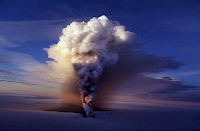The most active volcano Iceland has begun erupting, scientists said Saturday - a little more than a year after the outbreak of the North Atlantic island were closed air for days.
Icelandic Meteorological Office confirmed that an outbreak began in Grímsvötn volcano, accompanied by a series of small earthquakes. The smoke could be seen rising from the volcano, located in the Vatnajökull glacier in the uninhabited south Iceland.
An air exclusion zone designated for the 120 nautical miles (220 kilometers) in all directions of the epidemic. Isavia, the company that develops and operates all airport facilities and air navigation services in Iceland, described this procedure as a standard around the home.
"Plumes of smoke reached the height of the jet is in flight, and plans were made for aircraft flying for the control of airspace to fly southwardly Iceland tonight," said Hjordis Gudmundsdottir, a spokesman for isavi.
Grimsvotn last erupted in 2004. Scientists have been waiting for a new outbreak, and has already said that the eruption of the volcano is probably small and should not lead to chaos caused by air in April 2010 Eyjafjallajökull ashes of the volcano.
History shows that in a previous outbreak Grímsvötn not have much impact on air travel - in contrast to the massive disruption caused last year.
Pall Einarsson, geophysicist at the University of Iceland, said that the eruption of last year was a rare event.
"The ashes of Eyjafjallajokull had persistent or relentless and fine-grained," Einarsson said. "The ashes of Grímsvötn is more serious and less likely to cause danger, as it falls to earth faster and not stay too long in the air by the outbreak Eyjafjallajokull."
Iceland Coast Guard aircraft involved experts from the University of Iceland flies to the volcano and assess the situation.
An eyewitness, "said Bolli Valgardsson plume increased rapidly to several thousand feet (meters) into the air.
Low density of population in Iceland is one of the most active volcanoes in the world and eruptions are frequent.
Eruptions often cause local flooding in the fusion of the glacier, but rarely causes death.
epidemic last year Eyjafjallajökull left about 10 million air passengers stranded in the world after the wind blows the ash cloud some of the busiest airspace in the world and led for most countries in North EU to give all flights in five days.
If there is a widespread disruption occurs again depends on how long the eruption, how high ash plume rose and in which direction the wind blows.
In November, melted glacial ice began to flow from Grímsvötn, indicating a possible eruption. It was a false alarm, but scientists have been monitoring the volcano closely since then.
The volcano also erupted in 1998, 1996 and 1993. The eruption lasted from one day to several weeks.
Source: HuffingtonPost










No comments:
Post a Comment